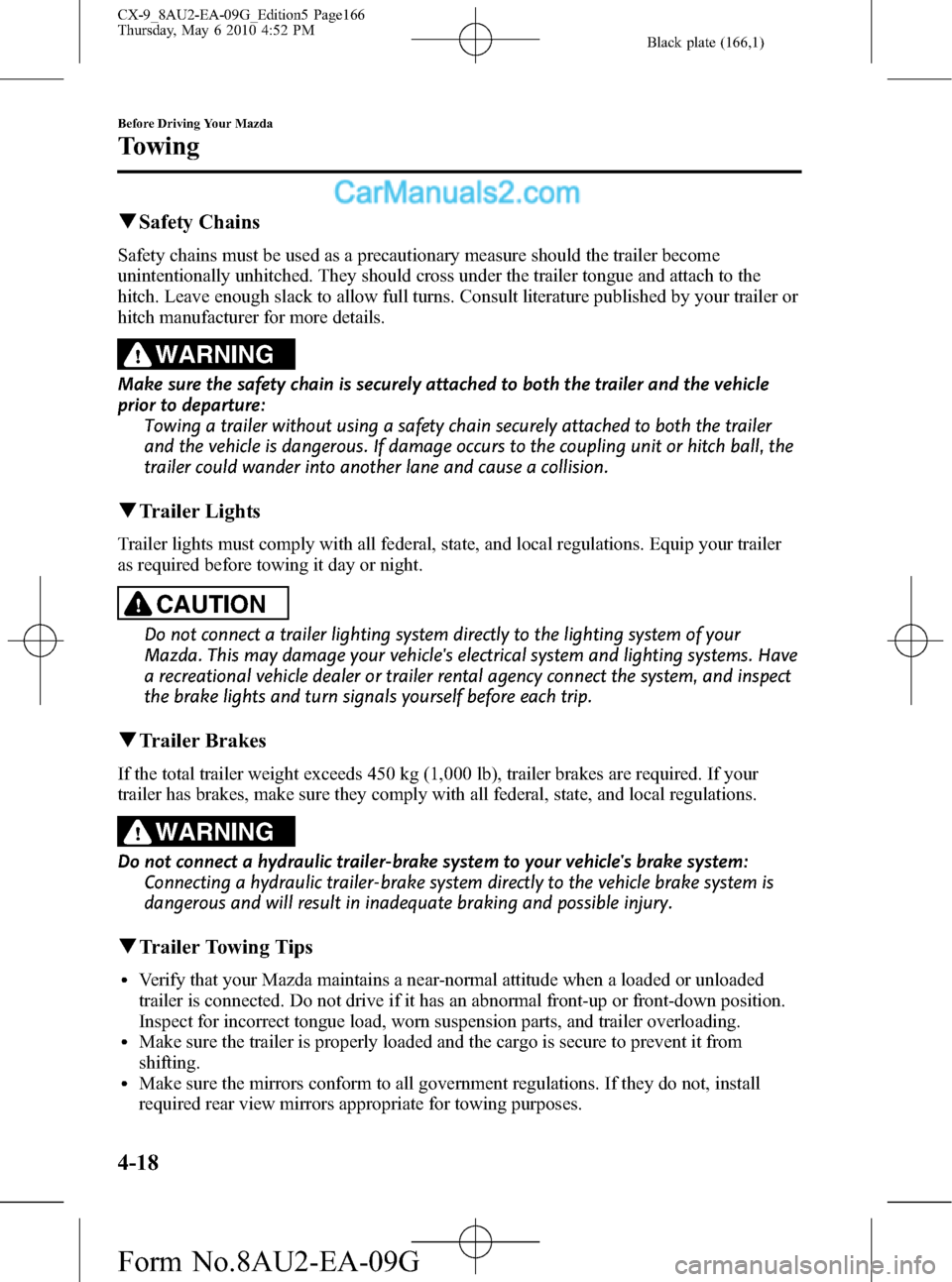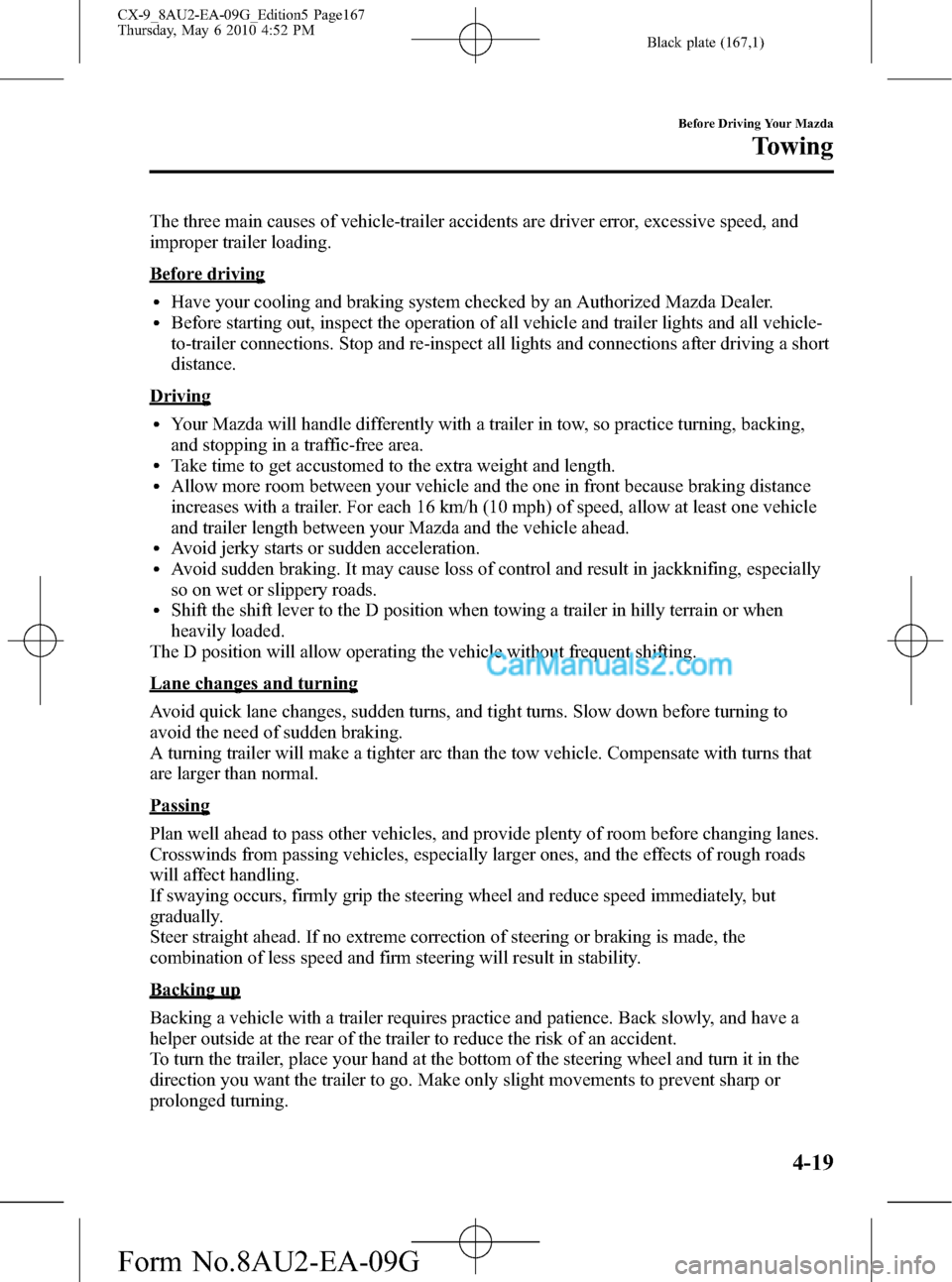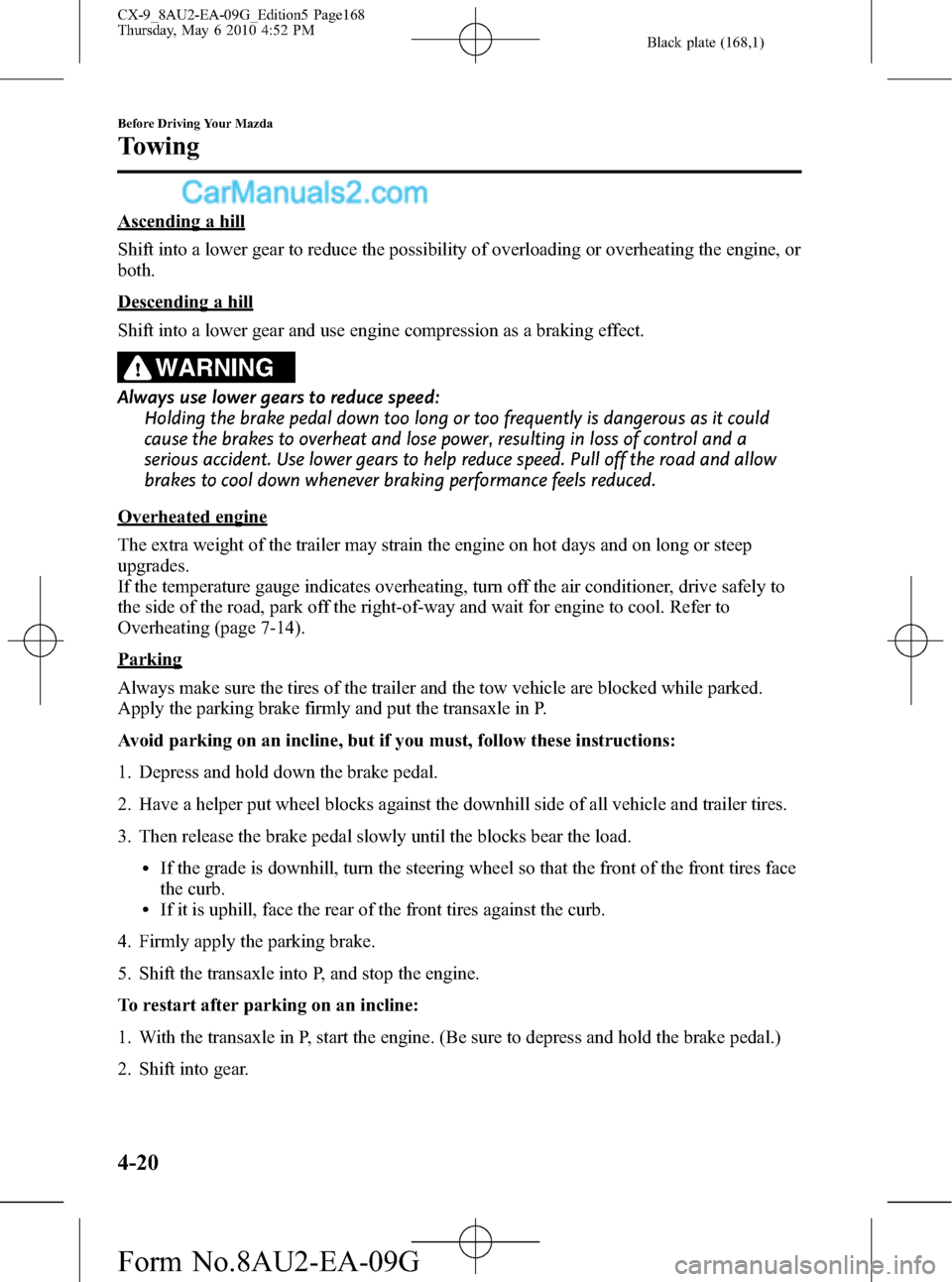MAZDA MODEL CX-9 2010 Owners Manual (in English)
Manufacturer: MAZDA, Model Year: 2010, Model line: MODEL CX-9, Model: MAZDA MODEL CX-9 2010Pages: 592
Page 161 of 592

Black plate (161,1)
Driving on Uneven Road
Your vehicle's suspension and underbody can be damaged if driven on rough/uneven roads
or over speed bumps at excessive speeds. Use care and reduce speed when traveling on
rough/uneven roads or over speed bumps.
Use care not to damage the vehicle's underbody, bumpers or muffler(s) when driving under
the following conditions:
lAscending or descending a slope with a sharp transition anglelAscending or descending a driveway or trailer ramp with a sharp transition angle
Your vehicle is equipped with low profile tires allowing class-leading performance and
handling. As a result, the sidewall of the tires are very thin and the tires and wheels can be
damaged if driven through potholes or on rough/uneven roads at excessive speeds. Use
care and reduce speed when traveling on rough/uneven roads or through potholes.
Before Driving Your Mazda
Driving Tips
4-13
CX-9_8AU2-EA-09G_Edition5 Page161
Thursday, May 6 2010 4:52 PM
Form No.8AU2-EA-09G
Page 162 of 592

Black plate (162,1)
Trailer Towing (Except Mexico)
Your Mazda was designed and built primarily to carry passengers and cargo.
If you tow a trailer, follow these instructions because driver and passenger safety depends
on proper equipment and safe driving habits. Towing a trailer will affect handling, braking,
durability, performance, and economy.
Never overload vehicle or trailer. Consult an Authorized Mazda Dealer if you need further
details.
CAUTION
Do not tow a trailer during the first 1,000 km (600 miles) of your new Mazda. If you
do, you may damage the engine, transaxle, differential, wheel bearings, and other
power train components.
qWeight Limits
TTW and GCWR
The total trailer weight (TTW), gross combination weight rating (GCWR), gross axle
weight rating (GAWR), trailer load, and trailer tongue load must be within the
prescribed limits.
lThe total trailer weight (TTW) is the sum of the weights of the trailer load (trailer
weight plus cargo), trailer hitch, vehicle passengers, and vehicle load. Never allow
the total trailer weight (TTW) to exceed specifications in the Trailer Towing-Load
Table.
lThe maximum GCWR is the combination weight of the trailer and load plus the
towing vehicle (including trailer hitch, vehicle passengers, and load). It must not
exceed specifications in the load table.
GAWR and GVWR
Do not exceed front and rear GAWR (gross axle weight rating) and GVWR (gross vehicle
weight rating). If you do, vehicle handling, braking, and performance will be affected.
These values are also on the Motor Vehicle Safety Certification Label posted on the driver's
door frame.
4-14
Before Driving Your Mazda
Towing
CX-9_8AU2-EA-09G_Edition5 Page162
Thursday, May 6 2010 4:52 PM
Form No.8AU2-EA-09G
Page 163 of 592

Black plate (163,1)
High-altitude operation
In a high-altitude operating environment, a gasoline engine loses power at a rate of 3 % to
4 % per 304 m (1,000 ft) of elevation. In these conditions, a reduction in gross vehicle
weight and gross combination weight is recommended.
TRAILER TOWING-LOAD TABLE
Because vehicle weights vary, adjustments must be made to meet the requirements in this table.
ItemModel
Without Towing
PackageWith Towing
Package
MAX. FRONTAL
AREA
2.97 m2(32 ft2) 4.65 m2(50 ft2)
MAX. TTWAdd trailer's weight, load and hitch; vehicle
passengers and vehicle load
*1
907 kg (2,000 lb) 1,588 kg (3,500 lb)
MAX. GCWR
3,105 kg*2(6,845 lb) 3,786 kg*2(8,347 lb)
3,202 kg
*3(7,059 lb) 3,883 kg*3(8,560 lb)
MAX. GAWR
Front1,276 kg*2(2,813 lb)
1,307 kg*3(2,881 lb)
Rear1,400 kg*2(3,086 lb)
1,458 kg*3(3,214 lb)
MAX. GVWR
2,645 kg*2(5,831 lb)
2,744 kg
*3(6,049 lb)
TRAILER-TON-
GUE LOADTongue load
Tongue load/Trailer load × 100 = 10 % to
15 %
Trailer load
Before Driving Your Mazda
Towing
4-15
CX-9_8AU2-EA-09G_Edition5 Page163
Thursday, May 6 2010 4:52 PM
Form No.8AU2-EA-09G
Page 164 of 592

Black plate (164,1)
ItemModel
Without Towing
PackageWith Towing
Package
DISTRIBUTION
OF TRAILER
LOAD
Front 60 %
Rear 40 %
GCWR: Gross Combination Weight Rating (sum of TTW, vehicle weights and 2 passengers)
GAWR: Gross Axle Weight Rating
GVWR: Gross Vehicle Weight Rating
*1 i.e. baggage, food, camp gear
*2 2WD
*3 AWD
WARNING
Always keep tow loads within specified limits as indicated in the Trailer Towing-Load
Table:
Attempting to tow loads greater than those specified is dangerous as it may cause
serious handling and performance problems that could result in personal injury or
vehicle damage, or both.
Load your trailer with the weight about 60 % toward the front and 40 % toward the
rear:
Loading the trailer with more weight in the rear than in the front is dangerous.
Doing so could cause you to lose control. The trailer tongue load must be 10 %―15
% of the total trailer load (sum of the weights of the trailer and cargo).
Always have the total trailer weight and tongue load determined prior to departure:
Attempting to tow loads without determining the total trailer weight and tongue
load is dangerous. Trailer sway from crosswinds, rough roads or other causes could
result in loss of control and a serious accident.
CAUTION
The total trailer weight and tongue load can be determined by weighing the trailer
on platform scales at a highway weight station or a trucking company.
qTrailer Hitch
Use only a hitch ball recommended by the trailer manufacturer that conforms to the gross
trailer weight requirement.
When not towing a trailer, remove the trailer hitch (if detachable) to reduce the possibility
of damage as a result of the vehicle being rear-ended.
4-16
Before Driving Your Mazda
Towing
CX-9_8AU2-EA-09G_Edition5 Page164
Thursday, May 6 2010 4:52 PM
Form No.8AU2-EA-09G
Page 165 of 592

Black plate (165,1)
WARNING
Always make sure the trailer hitch is securely attached before departure:
An unsecured trailer hitch is dangerous as it causes greater trailer sway from
crosswinds, rough roads or other causes, resulting in loss of control and a serious
accident.
Examine all trailer-hitch mounting bolts regularly and tighten any that are loose. If
the hitch is removed, seal any open mounting holes to prevent exhaust, dust, water,
dirt and other foreign elements from filtering in, possibly endangering personal
safety and damaging your vehicle.
Do not install a hitch that stiffens the bumper as it will reduce the bumper's
performance.
Make sure there are no exhaust gas leaks into the passenger compartment if any
mounting bolts are connected to the body:
Modifying your vehicle exhaust system is dangerous. Exhaust gas entering the
vehicle could cause loss of consciousness or even death.
When mounting the trailer hitch, make no modifications to the vehicle exhaust
system.
CAUTION
ØMake all hitch adjustments with actual loads. Do not load and unload vehicle
while adjusting hitch. This action will change the vehicle height.
ØDo not use an axle-mounted hitch. This may damage the axle and related parts.
qTires
When towing a trailer, make sure all tires are inflated to the recommended cold-tire
pressure, as indicated on the tire pressure chart on the driver's door frame. Trailer tire size,
load rating, and inflation pressures should conform to tire manufacturer specifications.
WARNING
Never use the temporary spare tire when towing:
Using the temporary spare tire on your vehicle when towing a trailer is dangerous as
it could result in tire failure, loss of control, and injury to vehicle occupants.
Before Driving Your Mazda
Towing
4-17
CX-9_8AU2-EA-09G_Edition5 Page165
Thursday, May 6 2010 4:52 PM
Form No.8AU2-EA-09G
Page 166 of 592

Black plate (166,1)
qSafety Chains
Safety chains must be used as a precautionary measure should the trailer become
unintentionally unhitched. They should cross under the trailer tongue and attach to the
hitch. Leave enough slack to allow full turns. Consult literature published by your trailer or
hitch manufacturer for more details.
WARNING
Make sure the safety chain is securely attached to both the trailer and the vehicle
prior to departure:
Towing a trailer without using a safety chain securely attached to both the trailer
and the vehicle is dangerous. If damage occurs to the coupling unit or hitch ball, the
trailer could wander into another lane and cause a collision.
qTrailer Lights
Trailer lights must comply with all federal, state, and local regulations. Equip your trailer
as required before towing it day or night.
CAUTION
Do not connect a trailer lighting system directly to the lighting system of your
Mazda. This may damage your vehicle's electrical system and lighting systems. Have
a recreational vehicle dealer or trailer rental agency connect the system, and inspect
the brake lights and turn signals yourself before each trip.
qTrailer Brakes
If the total trailer weight exceeds 450 kg (1,000 lb), trailer brakes are required. If your
trailer has brakes, make sure they comply with all federal, state, and local regulations.
WARNING
Do not connect a hydraulic trailer-brake system to your vehicle's brake system:
Connecting a hydraulic trailer-brake system directly to the vehicle brake system is
dangerous and will result in inadequate braking and possible injury.
qTrailer Towing Tips
lVerify that your Mazda maintains a near-normal attitude when a loaded or unloaded
trailer is connected. Do not drive if it has an abnormal front-up or front-down position.
Inspect for incorrect tongue load, worn suspension parts, and trailer overloading.
lMake sure the trailer is properly loaded and the cargo is secure to prevent it from
shifting.
lMake sure the mirrors conform to all government regulations. If they do not, install
required rear view mirrors appropriate for towing purposes.
4-18
Before Driving Your Mazda
Towing
CX-9_8AU2-EA-09G_Edition5 Page166
Thursday, May 6 2010 4:52 PM
Form No.8AU2-EA-09G
Page 167 of 592

Black plate (167,1)
The three main causes of vehicle-trailer accidents are driver error, excessive speed, and
improper trailer loading.
Before driving
lHave your cooling and braking system checked by an Authorized Mazda Dealer.lBefore starting out, inspect the operation of all vehicle and trailer lights and all vehicle-
to-trailer connections. Stop and re-inspect all lights and connections after driving a short
distance.
Driving
lYour Mazda will handle differently with a trailer in tow, so practice turning, backing,
and stopping in a traffic-free area.
lTake time to get accustomed to the extra weight and length.lAllow more room between your vehicle and the one in front because braking distance
increases with a trailer. For each 16 km/h (10 mph) of speed, allow at least one vehicle
and trailer length between your Mazda and the vehicle ahead.
lAvoid jerky starts or sudden acceleration.lAvoid sudden braking. It may cause loss of control and result in jackknifing, especially
so on wet or slippery roads.
lShift the shift lever to the D position when towing a trailer in hilly terrain or when
heavily loaded.
The D position will allow operating the vehicle without frequent shifting.
Lane changes and turning
Avoid quick lane changes, sudden turns, and tight turns. Slow down before turning to
avoid the need of sudden braking.
A turning trailer will make a tighter arc than the tow vehicle. Compensate with turns that
are larger than normal.
Passing
Plan well ahead to pass other vehicles, and provide plenty of room before changing lanes.
Crosswinds from passing vehicles, especially larger ones, and the effects of rough roads
will affect handling.
If swaying occurs, firmly grip the steering wheel and reduce speed immediately, but
gradually.
Steer straight ahead. If no extreme correction of steering or braking is made, the
combination of less speed and firm steering will result in stability.
Backing up
Backing a vehicle with a trailer requires practice and patience. Back slowly, and have a
helper outside at the rear of the trailer to reduce the risk of an accident.
To turn the trailer, place your hand at the bottom of the steering wheel and turn it in the
direction you want the trailer to go. Make only slight movements to prevent sharp or
prolonged turning.
Before Driving Your Mazda
Towing
4-19
CX-9_8AU2-EA-09G_Edition5 Page167
Thursday, May 6 2010 4:52 PM
Form No.8AU2-EA-09G
Page 168 of 592

Black plate (168,1)
Ascending a hill
Shift into a lower gear to reduce the possibility of overloading or overheating the engine, or
both.
Descending a hill
Shift into a lower gear and use engine compression as a braking effect.
WARNING
Always use lower gears to reduce speed:
Holding the brake pedal down too long or too frequently is dangerous as it could
cause the brakes to overheat and lose power, resulting in loss of control and a
serious accident. Use lower gears to help reduce speed. Pull off the road and allow
brakes to cool down whenever braking performance feels reduced.
Overheated engine
The extra weight of the trailer may strain the engine on hot days and on long or steep
upgrades.
If the temperature gauge indicates overheating, turn off the air conditioner, drive safely to
the side of the road, park off the right-of-way and wait for engine to cool. Refer to
Overheating (page 7-14).
Parking
Always make sure the tires of the trailer and the tow vehicle are blocked while parked.
Apply the parking brake firmly and put the transaxle in P.
Avoid parking on an incline, but if you must, follow these instructions:
1. Depress and hold down the brake pedal.
2. Have a helper put wheel blocks against the downhill side of all vehicle and trailer tires.
3. Then release the brake pedal slowly until the blocks bear the load.
lIf the grade is downhill, turn the steering wheel so that the front of the front tires face
the curb.
lIf it is uphill, face the rear of the front tires against the curb.
4. Firmly apply the parking brake.
5. Shift the transaxle into P, and stop the engine.
To restart after parking on an incline:
1. With the transaxle in P, start the engine. (Be sure to depress and hold the brake pedal.)
2. Shift into gear.
4-20
Before Driving Your Mazda
Towing
CX-9_8AU2-EA-09G_Edition5 Page168
Thursday, May 6 2010 4:52 PM
Form No.8AU2-EA-09G
Page 169 of 592

Black plate (169,1)
3. Release the parking brake (also the foot brake) and pull away from the wheel blocks.
Stop; apply the parking brake and shift into P.
4. Have a helper retrieve the wheel blocks.
Fuel consumption
Trailer towing causes higher fuel consumption.
Maintenance
If you tow a trailer frequently, have your vehicle serviced as shown in Scheduled
Maintenance (page 8-3).
Before Driving Your Mazda
Towing
4-21
CX-9_8AU2-EA-09G_Edition5 Page169
Thursday, May 6 2010 4:52 PM
Form No.8AU2-EA-09G
Page 170 of 592

Black plate (170,1)
4-22
CX-9_8AU2-EA-09G_Edition5 Page170
Thursday, May 6 2010 4:52 PM
Form No.8AU2-EA-09G